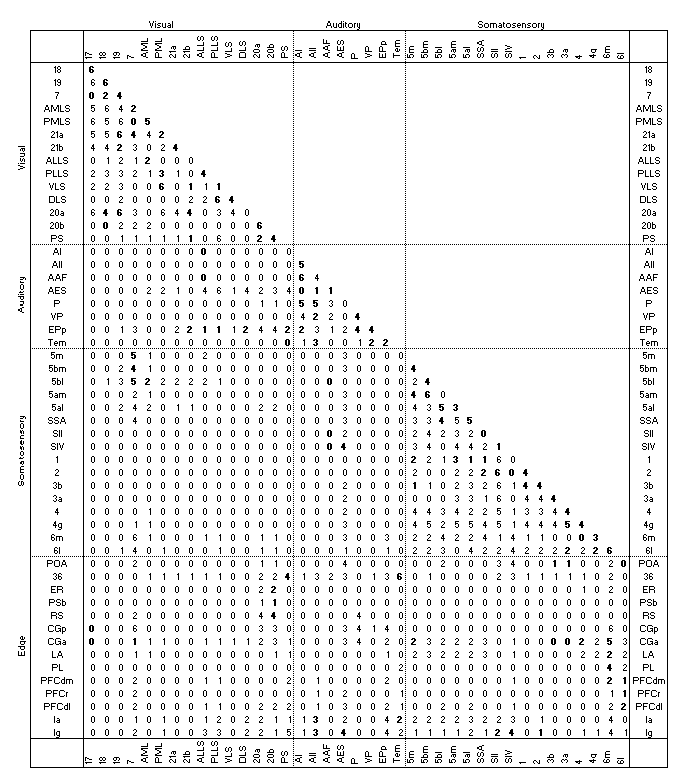
|
|
Fig. S4 . Parcellation of cerebral cortex of cat. Placement of the interconnected functional areas is evaluated for how well total connection-costs are minimized. (A) Connection-cost optimization analysis of layout of 15 contiguous areas of the visual cortex, along with 13 immediately contiguous "edge" areas. 126 connections are reported among the core areas and with their edge areas. (B) Similar combined analysis of 39 areas of the visual, auditory, and somatosensory cortex, along with 14 edge-areas (451 connections reported). Core and edge areas are listed in Table S2 connection matrix below. Lateral aspect only is shown. Rostral is to right.(4)
Table S2. Combined connection and adjacency matrix for cat visual, auditory, and somatosensory cortex. The series of 39 core areas as in Fig. S4 is listed, in the order in which the areas are successively added to the analysis (17 - 6l). They are followed by the set of 14 edge areas for the total core (POA - Ig). A cell with 0 indicates no known connection between the area of that row and of that column; 1 - 6 indicates connection between the two areas. (Afferent and efferent connection weights of 1 - 3 have been summed.) Cell values in bold designate topological contiguity of the two areas on the cortex sheet, as in Fig. S4.(5)


Fig. S5. Size Law for cat visual cortex areas. The system of components here is the 15 contiguous cat visual cortical areas in Fig. S4 (17 - PS), with connections and adjacencies as in Table S2. Optimality-measure is conformance of the system to the "all or nothing" adjacency rule, with each layout scored in terms of its number of violations of the rule. A series of nested compact subsets of the set of cortex areas was generated, each consisting of from 4 to the full 15 areas. Each subset of the actual layout was compared with all possible alternative layouts of that subset for adjacency-rule optimality.
The "Actual layout" curve shows that smaller subsets rank approximately in the middle of their group of alternative layouts. But, again, as subset size increases, optimality-ranking of the actual layout consistently improves (with one exception, p < 0.02). Only one in a hundred thousand of all alternative layouts conform to the adjacency rule better than the actual layout of the complete 15-component set. For comparison, the "Scrambled layout" broken-line curve shows the corresponding analysis for a layout of the 15 visual areas with their adjacencies randomly shuffled; no Size Law trend toward improving optimality is evident. Note that this analysis includes only 15 of the total 57 cortical areas.
Copyright Christopher Cherniak (2002)
Last Modified 11/19/2002